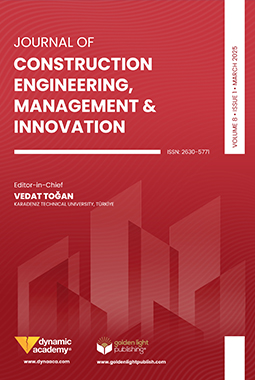ISSN:2630-5771
Journal of Construction Engineering, Management & Innovation
ARTICLES
Didem Ugurlu
Nicky Harris
Sevilay Demirkesen
Lean has been widely adopted in the construction industry since the last decade. However, the benefits of practicing Lean have not yet been well understood by construction practitioners. The low productivity and efficiency rates in construction require the implementation of innovative tools and techniques such as Lean construction (LC). However, it is challenging for the construction industry to adopt such new technologies and innovative methodologies. To overcome this challenge, this paper presents a Lean implementation framework for the construction practitioners operating in Turkey. In this respect, questionnaire-based research is conducted with professionals in the Turkish Construction Industry to identify the need, assessment, and implementation scheme for Lean. The framework indicates the importance of planning and management in the implementation process of LC. Moreover, it provides a roadmap for the organizations to implement LC successfully. The framework encourages organizations to analyze and identify their current state and create their value stream mapping along with developing a new policy and strategy for the lean culture. The results of this study are expected to guide construction practitioners with the implementation of LC and practice the components of the framework developed in the context of this study.
https://doi.org/10.31462/jcemi.2021.03117133
Aojoy Kumar Shuvo
Shayla Sharmin
Life cycle assessment (LCA) is a very familiar methodology to measure the environmental effects of any products where all the process associated with the products from cradle to grave was analyzed and the possible emission to environment can be identified. In this study we applied LCA on three traditionally constructed reinforced concrete buildings (one five storied residential building, one three storied office building and one three storied educational building) where no environmental issues was considered during design and construction period. The aim of this research is to evaluate and compare energy consumption and carbon emissions of three different types of buildings from their materialization stage to the end of life stage. This paper also describes the step by step process of quantifying the overall carbon emission from a building systematically. There is an overview of how emission varies according to buildings material, construction process and objective of buildings. The result shows that the operational phase is mainly responsible for maximum carbon emission due to maximum energy consumption among three phases of life cycle assessment. However, it is also found from the study that the materialization and operation stages together contribute more than 97% of total emissions. Since a huge amount of operational energy is required for commercial building compare to other two buildings, it consumes energy comparatively higher than residential and educational building which results in 13.6% more emission than residential building and 19% more than educational building.
https://doi.org/10.31462/jcemi.2021.03134150
Mahmoud Albahbah
Serkan Kıvrak
Gökhan Arslan
Augmented reality (AR) and virtual reality (VR) are advanced technologies that can provide significant advantages to the construction industry. In recent years, many researchers have focused on implementing AR and VR technologies in the construction project management domain, where these technologies have shown a significant contribution to the advancement of the construction project management aspects in many areas. However, there is a lack of a structured review that synthesizes the existing body of knowledge about the implementation of AR and VR technologies in the various aspects of construction project management. Therefore, this study aims to fill this gap via conducting a scoping review on the application areas of AR and VR technologies in construction project management. Ninety-four studies retrieved from peer-review journals and conference proceedings were included, reviewed, and analyzed. The studies were classified according to publication date, publication venue, study design, and geographical location. The main features of AR and VR systems, including the display method, interaction device, spatial registration method, and level of immersion, were identified and discussed. The application areas of each technology were thematically analyzed and classified under main topics, where the results revealed seven application areas for AR technology and five application areas for VR in the construction project management aspects.
https://doi.org/10.31462/jcemi.2021.03151172
Önder Halis Bettemir
Engin ÖZDEMİR
Didem EREN SARICI
In this study, a decision support system is developed to aid selection of earthwork equipment. Physical and economical attributes of five off the shelf dozers, three excavators, and seven hydraulic hammers are entered to a spreadsheet application. Seven seismic velocity-mechanical property relationships of rock and stiff soil are derived from the literature and defined to the spreadsheet application. Mechanical properties of the soil samples obtained from the construction site are entered to the relevant data cells and seismic velocity to be measured at the field is estimated. Developed system estimates the ripper outputs of the dozers by using ripper production charts, cost and duration of the earthwork task is computed and likelihoods of the feasibility of the construction machines are estimated. Developed system takes the construction duration into account and solves time-cost trade-off problem for the selection of the best construction machine. Developed methodology is implemented on the excavation of the foundations of a mass public housing project with 72 houses. Utilization of ripper production charts without performing seismic velocity tests become possible by the proposed method. Furthermore, time cost trade-off problem is formed and solved without human interruption. The developed decision support system proposes the construction machine with least total direct and indirect costs. Contractors would be able to reduce their construction costs and gain competitive advantage on their rivals, if they implement the proposed system.
https://doi.org/10.31462/jcemi.2021.03173186


